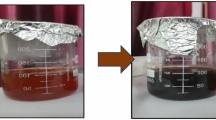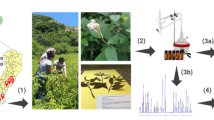Abstract
The excessive accumulation of Reactive oxygen species (ROS) has been linked to myriad of toxic effects in several signaling pathways including growth regulatory pathways and apoptosis in insects. The current upsurge in mosquito research into the underlying mechanism of phytochemicals induced reactive oxygen species accumulation and larvicidal potential prompts the attention to exploring the role of oxidative stress and microbial consortia inhabited in the mosquitoes. In addition, understanding the impacts of mosquito microbiomes annihilation is vital for disentangling their underlying effects on arboviral diseases transmission. No investigation has been conducted in this aspect using isolated bioactive compounds from Jasminum brevilobum, Aglaia edulis and Pogostemon auricularius against Aedes aegypti. This study aimed to investigate the mode of action of bioactive compounds with special inference on ROS production and microbial inhabitants. Isolation and characterization of bioactive compounds were performed using the Thin-layer chromatography, Column chromatography, Gas chromatography-mass spectrometry and Fourier-transform infrared spectroscopy. R software and SPSS were used for statistical analyses. The isolated bioactive compounds induced excessive production of reactive oxygen species thereby leading to oxidative stress and death. All the isolated compounds exhibited a sturdy inhibitory effect against Staphylococcus aureus, Bacillus subtilis, Escherichia coli, Klebsiella pneumonia, and Proteus mirabilis, with strong MIC values ranging from 0.08–1.65 mg/ml. Also, they showed promising larvicidal efficacy against Aedes aegypti larvae.





Similar content being viewed by others
References
Abirami P, Rajendran A (2012) GC-MS analysis of methanol extracts of Vernonia cinerea. Euro J Exp Biol 2:9–12
Aivazi AA, Vijayan VA (2009) Larvicidal activity of oak Quercus infectoria Oliv.(Fagaceae) gall extracts against Anopheles stephensi Liston. Parasitol Res 104(6):1289
Anoopkumar AN, Puthur S, Rebello S, Aneesh EM (2017a) Screening of a Few traditionally used Medicinal Plants for their Larvicidal Efficacy against Aedes aegypti Linn (Diptera: Culicidae), a Dengue Fever Vector. SOJ Microbiol Infect Dis 5:1–5. https://doi.org/10.15226/sojmid/5/4/00181
Anoopkumar AN, Puthur S, Varghese P, Rebello S, Aneesh EM (2017b) Life cycle, bio-ecology and DNA barcoding of mosquitoes Aedes aegypti (Linnaeus) and Aedes albopictus (Skuse). J Commun Dis 49. https://doi.org/10.24321/0019.5138.201719
Anoopkumar AN, Puthur S, Rebello S, Aneesh EM (2019) Molecular characterization of Aedes, Culex, Anopheles, and Armigeres vector mosquitoes inferred by mitochondrial cytochrome oxidase I gene sequence analysis. Biologia 1–14. https://doi.org/10.2478/s11756-019-00231-0
Arora R, Sharma P, Kapila K (1958) Antiarrhythmic and anticonvulsant activity of jatamansone. Indian J Med Res 46:782–791
Astill B, Terhaar C, Fassett D (1972) The toxicology and fate of 2, 2, 4-trimethyl-1, 3-pentanediol diisobutyrate. Toxicol Appl Pharmacol 22:387–399
Azambuja P, Garcia ES, Ratcliffe NA (2005) Gut microbiota and parasite transmission by insect vectors. Trends Parasitol 21:568–572. https://doi.org/10.1016/j.pt.2005.09.011
Bennett RN, Wallsgrove RM (1994) Secondary metabolites in plant defence mechanisms. New Phytol 127:617–633
Bhatt S, Gething PW, Brady OJ, Messina JP, Farlow AW, Moyes CL, Drake JM, Brownstein JS, Hoen AG, Sankoh O, Myers MF, George DB, Jaenisch T, Wint GR, Simmons CP, Scott TW, Farrar JJ, Hay SI (2013) The global distribution and burden of dengue. Nature 496:504–507. https://doi.org/10.1038/nature12060
Bussmann R et al (2010) Minimum inhibitory concentrations of medicinal plants used in northern Peru as antibacterial remedies. J Ethnopharmacol 132:101–108. https://doi.org/10.1016/j.jep.2010.07.048
Cantrell CL, Dayan FE, Duke SO (2012) Natural products as sources for new pesticides. J Nat Prod 75:1231–1242. https://doi.org/10.1021/np300024u
Chen KKBM, Oxford UK (1965) Pharmacology of oriental plants vol 51. Pergamon Press Ltd
Coon KL, Valzania L, McKinney DA, Vogel KJ, Brown MR, Strand MR (2017) Bacteria-mediated hypoxia functions as a signal for mosquito development. Proc Natl Acad Sci U S A 114:E5362–E5369. https://doi.org/10.1073/pnas.1702983114
Devasagayam T, Tilak J, Boloor K, Sane KS, Ghaskadbi SS, Lele R (2004) Free radicals and antioxidants in human health: current status and future prospects Japi 52:4
Dillon R, Dillon V (2004) The gut bacteria of insects: nonpathogenic interactions. Annu Rev Entomol 49:71–92. https://doi.org/10.1146/annurev.ento.49.061802.123416
Gallicchio V, Casale G, Watts T (1987) Inhibition of human bone marrow-derived stem cell colony formation (CFU-E, BFU-E, and CFU-GM) following in vitro exposure to organophosphates. Exp Hematol 15:1099–1102
Gulland A (2016) Zika virus is a global public health emergency, declares WHO. British Medical Journal Publishing Group https://doi.org/10.1136/bmj.i657
Jayakrishnan L, Sudhikumar AV, Aneesh EM (2018) Role of gut inhabitants on vectorial capacity of mosquitoes. J Vector Borne Dis 55:69. https://doi.org/10.4103/0972-9062.242567
Jones JD, Dangl JL (2006) The plant immune system nature 444:323. https://doi.org/10.1038/nature05286
Joseph C, Ndoile M, Malima R, Nkunya M (2004) Larvicidal and mosquitocidal extracts, a coumarin, isoflavonoids and pterocarpans from Neorautanenia mitis. Trans R Soc Trop Med Hyg 98:451–455. https://doi.org/10.1016/j.trstmh.2003.10.008
Kodak (1971) Company Reports 21MAY 21MAY
Kunwar A, Priyadarsini K (2011) Free radicals, oxidative stress and importance of antioxidants in human health. J Med Allied Sci 1:53–60. https://doi.org/10.1007/s11746-998-0032-9
Lenaz G, Bovina C, D'aurelio M, Fato R, Formiggini G, Genova ML, Giuliano G, Pich MM, Paolucci UG, Castelli GP, Ventura B (2002) Role of mitochondria in oxidative stress and aging. Ann N Y Acad Sci 959(1):199–213. https://doi.org/10.1111/j.1749-6632.2002.tb02094.x
Mandal SM, Chakraborty D, Dey S (2010) Phenolic acids act as signaling molecules in plant-microbe symbioses. Plant Signal Behav 5:359–368. https://doi.org/10.4161/psb.5.4.10871
Mittler R, Vanderauwera S, Gollery M, Van Breusegem F (2004) Reactive oxygen gene network of plants. Trends Plant Sci 9:490–498. https://doi.org/10.1016/j.tplants.2004.08.009
Oliveira Melo AS, Malinger G, Ximenes R, Szejnfeld PO, Alves Sampaio S, Bispo de Filippis AM (2016) Zika virus intrauterine infection causes fetal brain abnormality and microcephaly: tip of the iceberg? Ultrasound Obstet Gynecol 47(1):6–7. https://doi.org/10.1002/uog.15831
Oliveira JHM, Talyuli OA, Goncalves RL, Paiva-Silva GO, Sorgine MHF, Alvarenga PH, Oliveira PL (2017) Catalase protects Aedes aegypti from oxidative stress and increases midgut infection prevalence of Dengue but not Zika. PLoS Negl Trop Dis 11:e0005525. https://doi.org/10.1371/journal.pntd.0005525
Pitarokili D, Michaelakis A, Koliopoulos G, Giatropoulos A, Tzakou O (2011) Chemical composition, larvicidal evaluation, and adult repellency of endemic Greek Thymus essential oils against the mosquito vector of West Nile virus. Parasitol Res 109:425–430. https://doi.org/10.1007/s00436-011-2271-1
Poole SK, Dean TA, Oudsema JW, Poole CF (1990) Sample preparation for chromatographic separations: an overview. Anal Chim Acta 236:3–42. https://doi.org/10.1016/S0003-2670(00)83297-3
Prieto P, Pineda M, Aguilar M (1999) Spectrophotometric quantitation of antioxidant capacity through the formation of a phosphomolybdenum complex: specific application to the determination of vitamin E. Anal Biochem 269:337–341. https://doi.org/10.1006/abio.1999.4019
Puthur S, Anoopkumar AN, Rebello S, Aneesh EM (2018) Hypericum japonicum: a double-headed sword to combat vector control and cancer Applied biochemistry and biotechnology:1–11. https://doi.org/10.1007/s12010-018-2713-7
Puthur S, Anoopkumar AN, Rebello S, Aneesh EM (2019) Synergistic control of storage pest rice weevil using Hypericum japonicum and deltamethrin combinations: a key to combat pesticide resistance Environmental Sustainability:1–7. https://doi.org/10.1007/s42398-019-00086-w
Rao KVB, Munjal M, Patnayak A, Karthik L, Kumar G (2013) Phytochemical composition, antioxidant, antimicrobial and cytotoxic potential of methanolic extracts of Adhatoda vasica (Acanthaceae). Asian J Res Chem 6:1004
Rebello S, Anoopkumar AN, Puthur S, Sindhu R, Binod P, Pandey A, Aneesh EM (2018) Zinc oxide phytase nanocomposites as contributory tools to improved thermostability and shelflife. Bioresour Technol Rep 3:1–6. https://doi.org/10.1016/j.biteb.2018.05.007
Rebello S, Balakrishnan D, Anoopkumar AN, Sindhu R, Binod P, Pandey A, Aneesh EM (2019a) Industrial enzymes as feed supplements—advantages to nutrition and global environment. In: Green Bio-processes. Springer, pp 293–304. https://doi.org/10.1007/978-981-13-3263-0_15
Rebello, S., Anoopkumar, A., Aneesh, E. M., Sindhu, R., Binod, P., & Pandey, A. (2019b). Sustainability and life cycle assessments of lignocellulosic and algal pretreatments. Bioresour Technol, 122678. https://doi.org/10.1016/j.biortech.2019.122678
Rosenberg E, Zilber-Rosenberg I (2011) Symbiosis and development: the hologenome concept Birth Defects Research Part C: Embryo Today: Reviews 93:56–66. https://doi.org/10.1002/bdrc.20196
Sahu R, Dhongade H, Pandey A, Sahu P, Sahu V, Patel D (2016) Medicinal Properties of Nardostachys jatamansi (A Review). Orient J Chem 32:859–866. https://doi.org/10.13005/ojc/320211
Sarwar M, Ahmad N, Toufiq M (2009) Host plant resistance relationshiphs in chickpea (Cicer arietinum l.) against gram pod borer (Helicoverpa armigera) hubner. Pak J Bot 41:3047–3052
Shaalan EA-S, Canyon D, Younes MWF, Abdel-Wahab H, Mansour A-H (2005) A review of botanical phytochemicals with mosquitocidal potential. Environ Int 31:1149–1166. https://doi.org/10.1016/j.envint.2005.03.003
Sies H (1997) Oxidative stress: oxidants and antioxidants experimental physiology: translation and. Integration 82:291–295
Team RC (2013) R: a language and environment for statistical computing
Thongwat D, Lamlertthon S, Pimolsri U, Bunchu N (2017) Larvicidal activity of endocarp and seed crude extracts of Dracaena loureiri Gagnep against Aedes aegypti (L.) mosquito. Asian Pac J Trop Biomed 7:222–226. https://doi.org/10.1016/j.apjtb.2016.12.005
Tilak JC, Adhikari S, Devasagayam TP (2004) Antioxidant properties of Plumbago zeylanica, an Indian medicinal plant and its active ingredient, plumbagin. Redox Rep 9:219–227
Valzania L, Martinson VG, Harrison RE, Boyd BM, Coon KL, Brown MR, Strand MR (2018) Both living bacteriaand eukaryotes in the mosquito gut promote growth of larvae. PLoS Negl Trop Dis 12:e0006638. https://doi.org/10.1371/journal.pntd.0006638
Vijayan V (2010) Laboratory selection of carbofuran tolerant line of Culex quinquefasciatus say, the filarial vector at Mysore. J Commun Disord 42(3):201–207
Wang Z, Perumalsamy H, Wang X, Ahn Y-J (2019) Toxicity and possible mechanisms of action of honokiol from Magnolia denudata seeds against four mosquito species. Sci Rep 9:411. https://doi.org/10.1038/s41598-018-36558-y
WHO (1986) Resistance of vectors and reservoirs of disease to pesticides: tenth report of the WHO Expert Committee on Vector Biology and Control [meeting held in Geneva from 5 to 11 November 1985]
WHO (2005) World Health Organization. Guidelines for laboratory and field testing of mosquito larvicides Geneva: World Health Organization:p 1–41. https://apps.who.int/iris/handle/10665/69101
WHO (2018) World health statistics 2018: monitoring health for the SDGs, sustainable development goals. Geneva: World Health Organization; 2018. Licence: CC BY-NC-SA 3.0 IGO. Available at https://www.who.int/gho/publications/world_health_statistics/2018/en/
Wiegand I, Hilpert K, Hancock RE (2008) Agar and broth dilution methods to determine the minimal inhibitory concentration (MIC) of antimicrobial substances. Nat Protoc 3:163. https://doi.org/10.1038/nprot.2007.521
Wright MH, Lee CJ, Arnold MSJ, Shalom J, White A, Greene AC, Cock IE (2017) GC-MS analysis of Tasmannia lanceolata Extracts which Inhibit the Growth of the Pathogenic Bacterium Clostridium perfringens. Pharmacogn J 9. https://doi.org/10.5530/pj.2017.5.100
Yadav KK, Bora A, Datta S, Chandel K, Gogoi HK, Prasad G, Veer V (2015) Molecular characterization of midgut microbiota of Aedes albopictus and Aedes aegypti from Arunachal Pradesh, India Parasites & vectors 8:641. https://doi.org/10.1186/s13071-015-1252-0, 8
Yang Y-C, Lee S-G, Lee H-K, Kim M-K, Lee S-H, Lee H-S (2002) A piperidine amide extracted from Piper longum L. fruit shows activity against Aedes aegypti mosquito larvae. J Agric Food Chem 50:3765–3767. https://doi.org/10.1021/jf011708f
Acknowledgments
The authors would like to thank Principal, St. Joseph’s College, Irinjalakuda for the laboratory facilities provided. The author Embalil Mathachan Aneesh thanks University Grants Commission, Government of India (UGC Research Award - F30-6/20-16(SA-II)) and Department of Biotechnology (BT/IN/Indo-US/Foldscope/39/2015) for funding.
Funding
The study was financed by UGC Research Award (F30–6/20–16(SA-II) and DBT Foldscope project (BT/IN/Indo-US/Foldscope/39/2015).
Author information
Authors and Affiliations
Corresponding author
Ethics declarations
Conflict of interest
The authors declare that they have no conflict of interest.
Ethical statement
This article does not contain any studies with human participants or animals performed by any of the authors.
Additional information
Publisher’s note
Springer Nature remains neutral with regard to jurisdictional claims in published maps and institutional affiliations.
Rights and permissions
About this article
Cite this article
Anoopkumar, A.N., Aneesh, E.M. & Sudhikumar, A.V. Exploring the mode of action of isolated bioactive compounds by induced reactive oxygen species generation in Aedes aegypti: a microbes based double-edged weapon to fight against Arboviral diseases. Int J Trop Insect Sci 40, 573–585 (2020). https://doi.org/10.1007/s42690-020-00104-z
Received:
Accepted:
Published:
Issue Date:
DOI: https://doi.org/10.1007/s42690-020-00104-z




